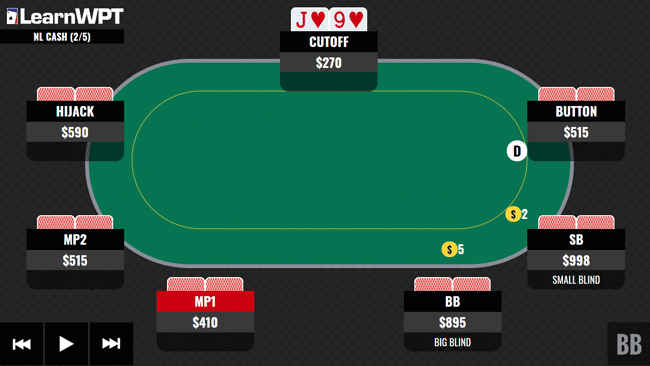J♥9♥ Facing a Turn Bet, what do you do here?
DECISION POINT: In a live $2-5 game it folds to you in the Cutoff set with J♥9♥, you raise to $20, and the Small Blind and Big Blind call. Both opponents check the J♦7♣4♣ flop, you c-bet $40, and only the Small Blind calls. The turn is J♣ and the Small Blind bets $150. Action is on you, what do you do here?
PRO ANSWER: We are playing in a $2-5 cash game we are dealt J♥9♥ in the Cutoff seat with the effective stack of $270. Action folds to us and we make a standard raise for this game to $20. Both Blinds call and everyone else folds.
The flop is J♦7♣4♣ and both opponents check to us. Typically in multiway pots in many small stakes cash games we can get away with 40-50% pot bets because players tend to play a lot more “honest”. Most players tend to not try and bluff as much in multiway pots as they do in heads up pots because they are less likely to work. That doesn’t mean that bluffs never work in this spot, it’s just that they are significantly less likely to work when multiway. We do elect to make a continuation bet a little on the higher side at $40 and are called by just the Small Blind.
The turn is the J♣ and the Small Blind bets $150 into the $140 pot. This is a very interesting spot for us because this sort of betting pattern likely polarizes their range. The Small Blind is likely to bet here for two reasons. The first is a semi-bluff where they have a hand with some equity like TcTx , 9c9x, or a less often a dry Ac that is designed to get us to fold. The second would be with made hands that are vulnerable such as other Jx hands or small flushes that wouldn’t want a fourth club to fall on the river.
Continued below...
It’s unlikely (but not impossible) the Small Blind will play a full house this way. There is no real danger to giving a free card and they would typically want to invite action. Over betting the pot doesn’t accomplish that task very well.
When evaluating spots like this it can be helpful is to think of where exactly our hand falls in our range. When we’re in the top 25% of our range we should rarely consider folding in a situation. If we do fold, we are exploitable as we are folding too often. There are MANY hands we would continuation bet on this board that are far worse than J9s on the turn, so from a theoretical standpoint we are just too high up in our range to be folding here by default.
There are certainly players who are rarely bluffing in this spot that we could make an exploitative fold against if we had an exploitative read, but by default we are simply too high up in our range to fold.
Calling is the best play.
How would you play it?
Share your answer in the comments below!
Start Improving Your Game Today
Join LearnWPT ($5 Your First Month!) and Get:
Think Like a Pro
- The WPT GTO Trainer to play real solved hands and get instant feedback on YOUR leaks
- On-demand access to our full library of 450+ Strategy Episodes
- All of your poker questions answered with the Ask a Pro Feature
- Expert analysis from LearnWPT Pros using The Hand Input Tool
- Community Forums to discuss all things poker with fellow LearnWPT Members
- Downloadable Tools you can use at and away from the tables
To join (just $5 your 1st month) click the JOIN NOW button at the top of your screen or the button below and start improving your game!
Have Questions about LearnWPT? Email us at [email protected] and we’ll be happy to help!

